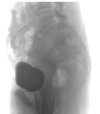Delayed presentation of postcaesarean section vesicouterine fistula repaired robotically
- PMID: 33504516
- PMCID: PMC7843336
- DOI: 10.1136/bcr-2020-234902
Delayed presentation of postcaesarean section vesicouterine fistula repaired robotically
Abstract
A premenopausal patient in her late forties presented with a 15-year history of urinary incontinence starting shortly after a caesarean section performed for her fourth delivery and more recently associated episodic light haematuria and passage of clots per vagina. The haematuria was intermittent over several months and associated with per-vaginal bleeding. She had symptomatic anaemia. Flexible cystoscopy and MRI showed a vesicouterine fistula. She underwent a robotic-assisted hysterectomy and multi-layered repair of the bladder with omental interposition. She remained in the hospital for 4 days, though recovered well and underwent catheter removal at 14 days following a normal cystogram. At 3 months, she was well with no incontinence or urinary symptoms. This case demonstrates the need for vigilance in assessing patients with persistent incontinence, particularly in the context of prior caesarean section. It highlights the feasibility of robotic surgery for correcting these defects in a society where minimally invasive surgery is becoming the norm, and cosmesis is a priority for patients.
Keywords: hematuria; incontinence; pregnancy; surgery; urological surgery.
© BMJ Publishing Group Limited 2020. No commercial re-use. See rights and permissions. Published by BMJ.
Conflict of interest statement
Competing interests: None declared.
Figures





Similar articles
-
Robotic repair of a branching vesicouterine and vesicovaginal fistula.Int Urogynecol J. 2023 Feb;34(2):593-595. doi: 10.1007/s00192-022-05368-2. Epub 2022 Sep 28. Int Urogynecol J. 2023. PMID: 36169680
-
Delayed Diagnosis of Vesicouterine Fistula After Treatment for Mixed Urinary Incontinence: Menstrual Cup Management and Diagnosis.Female Pelvic Med Reconstr Surg. 2016 Sep-Oct;22(5):e29-31. doi: 10.1097/SPV.0000000000000301. Female Pelvic Med Reconstr Surg. 2016. PMID: 27403759
-
Robotic-assisted vesicovaginal fistula repair using an extravesical approach without interposition grafting.J Robot Surg. 2018 Mar;12(1):173-176. doi: 10.1007/s11701-017-0694-0. Epub 2017 Mar 28. J Robot Surg. 2018. PMID: 28353196
-
Vesicouterine Fistula (Youssef Syndrome): Case Report and Literature Review.Rev Bras Ginecol Obstet. 2018 Sep;40(9):563-569. doi: 10.1055/s-0038-1666998. Epub 2018 Sep 19. Rev Bras Ginecol Obstet. 2018. PMID: 30231295 Free PMC article. Review.
-
A case with vesicouterine fistula: mini review.Arch Gynecol Obstet. 2012 Mar;285(3):667-70. doi: 10.1007/s00404-011-2188-z. Epub 2012 Jan 8. Arch Gynecol Obstet. 2012. PMID: 22228385 Review.
References
-
- World Health Organisation Obstetric Fistula [Internet]. Switzerland: WHO, 2018. https://www.who.int/news-room/facts-in-pictures/detail/10-facts-on-obste...
Publication types
MeSH terms
LinkOut - more resources
Full Text Sources
Other Literature Sources
Medical
